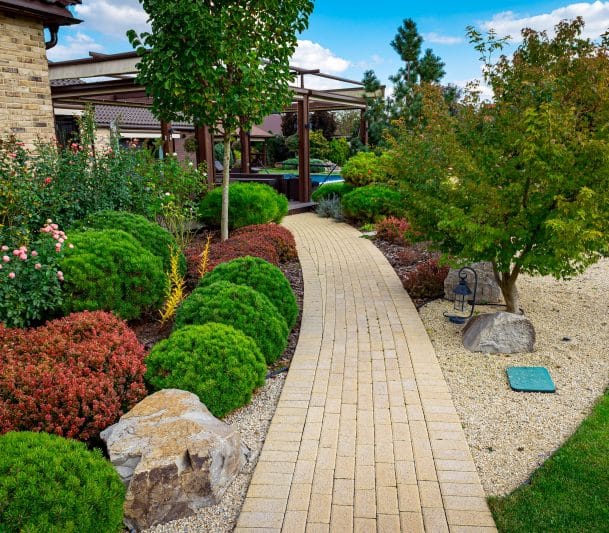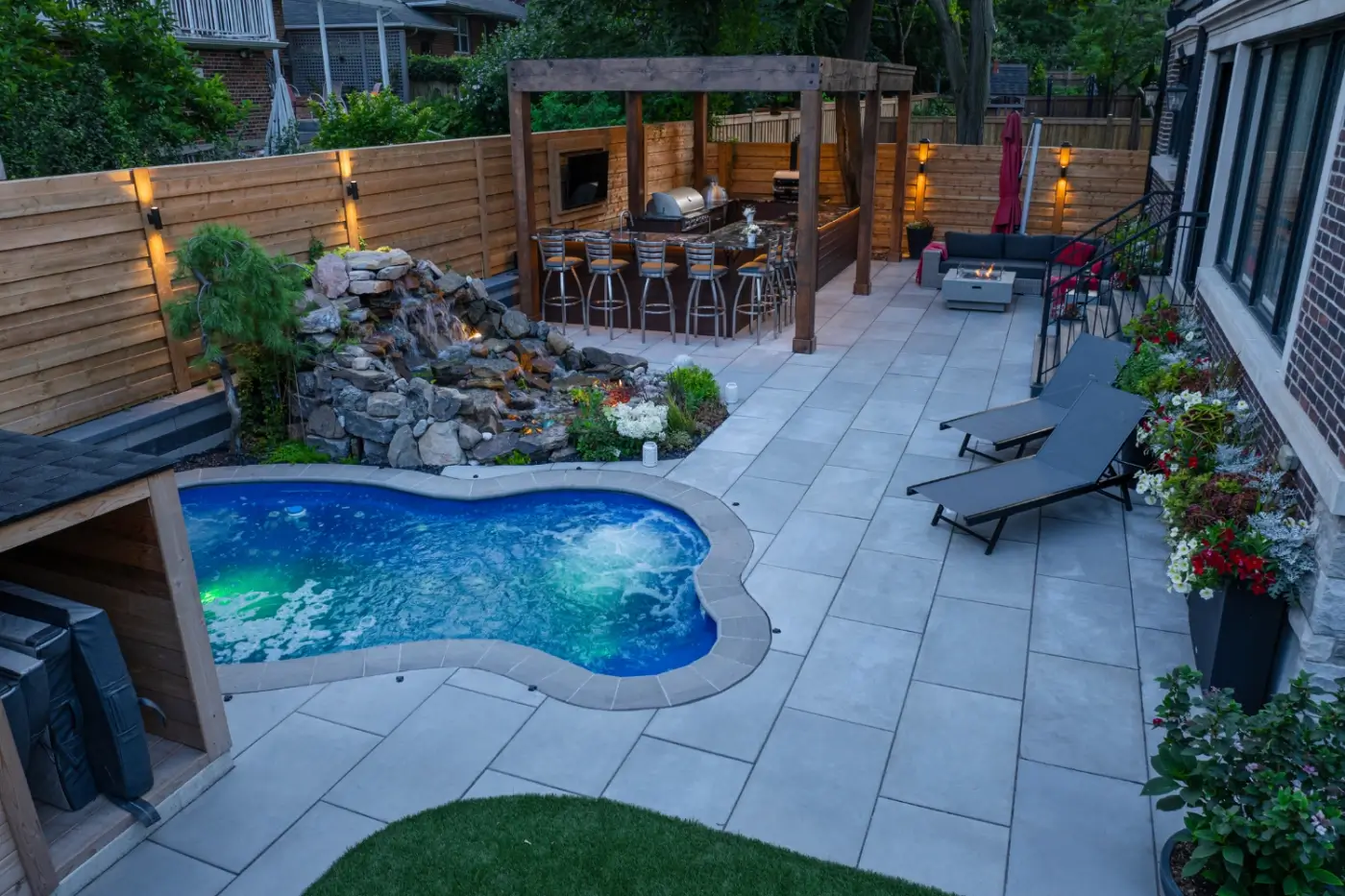Comprehending the Comprehensive Extent of Functions in Expert Landscaping Services
The substantial extent of expert landscape design services encompasses a variety of essential aspects - landscaping services. It consists of landscape design concepts, plant choice, and hardscaping features. In addition, it addresses watering systems and upkeep strategies. Each facet plays an important function in producing functional and visually pleasing outdoor spaces. Comprehending exactly how these components collaborate can disclose much concerning the art and scientific research of landscaping. The trip right into this elaborate field is simply starting.
Landscape Style Concepts
Efficient landscape design concepts are important for producing harmonious outdoor areas that improve both aesthetic allure and performance (Learn More). These concepts guide the plan of components within the landscape, making certain a natural visual experience. Trick parts include balance, which disperses aesthetic weight evenly; proportion, which associates the dimension of different elements to each other and the room; and unity, which produces a feeling of wholeness via consistent themes and materials

Plant Choice and Installment
In the domain name of specialist landscaping, plant choice and setup play an important role in accomplishing a prospering garden. Stressing native plant advantages, seasonal considerations, and the specific dirt and sunshine demands of each species assures a sustainable and cosmetically pleasing landscape. Cautious preparation in these areas not just improves biodiversity but also advertises long-lasting ecological health.
Indigenous Plant Advantages
Why should property owners consider indigenous plants for their landscaping jobs? Native plants use many benefits that improve both aesthetics and environmental sustainability. They are well-adapted to local environments, needing much less water and upkeep compared to non-native varieties. This resilience minimizes the demand for chemical fertilizers and chemicals, advertising a much healthier community. Furthermore, native plants offer habitat and food for regional wild animals, including pollinators, which can raise biodiversity in domestic locations. Their experience with local soil and climate problems also brings about far better growth rates and long life. By picking indigenous plants, property owners not only produce aesthetically attractive landscapes yet additionally add to ecological conservation, making a favorable influence on their neighborhood environment. Subsequently, indigenous plants stand for a clever choice for landscaping projects.
Seasonal Plant Considerations
House owners that have accepted indigenous plants in their landscaping can further improve their exterior areas by taking into consideration seasonal plant selections. By integrating plants that grow in specific seasons, they can develop vibrant and visually appealing landscapes throughout the year. Springtime might introduce vibrant blooms like tulips and daffodils, while summer season can display lush foliage and colorful perennials. Fall presents a combination of cozy tones with goldenrods and asters, while winter can be accentuated with evergreens and ornamental turfs for texture. Professional landscaping companies typically suggest choosing plants that not only enhance existing indigenous types however also provide year-round passion and assistance local wildlife. This thoughtful strategy to seasonal plant choice ensures a constantly evolving and lasting yard atmosphere.
Soil and Sunlight Needs
Successful landscaping depends upon understanding the particular soil and sunshine requirements of plants. Different types flourish under varying conditions, calling for a mindful analysis of both elements throughout the choice procedure. Dirt kinds, such as sandy, clay, or loamy, influence drainage, vitamins and mineral accessibility, and root advancement. In addition, pH levels can impact plant wellness, requiring dirt screening to identify suitability. Sunshine requirements vary substantially; some plants prosper in complete sun, while others like partial or full shade. A specialist landscaper considers these components to guarantee peak development and visual charm. By straightening plant choices with the atmosphere's specific attributes, landscapes can accomplish sustainability, resilience, and aesthetic harmony, inevitably causing successful plant facility and long-term maintenance.
Hardscaping Attributes and Construction

While landscape design frequently stimulates photos of lush greenery and dynamic flowers, hardscaping functions play a crucial role in specifying exterior spaces. These aspects, which consist of patio areas, walkways, retaining walls, and decorative stonework, provide structure and performance to yards and backyards. Hardscaping uses materials such as concrete, brick, timber, and rock, enabling for diverse designs that enhance the all-natural landscape.
The building and construction of hardscaping features requires cautious planning and implementation to assure durability and visual allure. Experts evaluate site problems, drain, and spatial connections to create cohesive outside environments. Correct installation methods are crucial, as they protect against problems like disintegration and moving in time.
Including hardscaping not just improves the aesthetic rate of interest of a home but additionally assists in outside activities, making it a basic aspect of thorough landscape design services. Inevitably, thoughtful hardscaping adds to both the performance and beauty of outside spaces.
Watering Equipments and Water Administration
Reliable irrigation systems and water monitoring are important parts of professional landscaping, as they assure that plants get the essential hydration for optimal growth. These systems can differ from basic drip irrigation arrangements to sophisticated automatic automatic sprinkler, made to meet the certain needs of varied landscapes. Appropriate water monitoring not just optimizes water usage, minimizing waste, yet also boosts plant health and wellness and minimizes disease dangers.
Landscape design professionals assess different aspects, consisting of dirt kind, plant varieties, and regional climate, to develop tailored irrigation options. In addition, including rainwater harvesting strategies can even more boost sustainability and efficiency. Regular maintenance of irrigation systems is vital to preserve performance and stop leakages, which can cause water loss and raised prices (Learn More). Eventually, a well-designed irrigation system plays a pivotal duty in protecting the aesthetic appeal of outside spaces while advertising ecological stewardship within professional landscape design methods
Yard Care and Upkeep Methods
Grass care and upkeep strategies are basic for achieving a lush, healthy yard that improves the overall landscape. These techniques include different methods focused on promoting ideal development and aesthetic appeal. Regular mowing is important, as it encourages thick, even growth while avoiding weeds from establishing. Additionally, correct fertilization supplies needed nutrients, with applications tailored to the particular turf type and soil problems.
Watering methods ought to focus on deep, irregular watering to encourage root growth, while aeration enhances dirt structure and promotes vitamins and mineral absorption. Pest and disease administration is likewise critical; determining problems early enables effective treatments that lessen damages.
Overseeding can revitalize thin or broken yards, improving thickness and color (landscaping). By executing these targeted yard treatment techniques, landscaping specialists can guarantee that backyards stay healthy and balanced and lively throughout the periods, substantially contributing to the overall appeal of the residential property
Seasonal Landscape Care and Maintenance
As the seasons modification, correct landscape treatment comes to be crucial for preserving the health and charm of outside areas. Each season offers one-of-a-kind obstacles and demands. In springtime, landscape specialists concentrate on trimming, planting, and feeding to encourage growth. Summertime demands regular watering, weed control, and insect administration to secure recently established plants.

Throughout the year, seasonal landscape upkeep guarantees that exterior areas remain visually appealing and healthy. Professional services can offer customized maintenance strategies that adjust to the certain demands of each period, allowing homeowner to enjoy vibrant landscapes year-round. Overall, seasonal treatment is a vital element of professional landscaping that promotes longevity and aesthetic value.

Sustainable Landscaping Practices
A growing number of residential property proprietors are welcoming lasting landscape design techniques to develop eco-friendly exterior rooms. These techniques focus on conserving resources, boosting biodiversity, and minimizing environmental impact. Native plants are usually chosen for their low tide demands and compatibility with regional environments, minimizing the requirement for chemical fertilizers and pesticides. Rain yards and absorptive paving are utilized to handle stormwater overflow, promoting groundwater recharge and minimizing disintegration.
In addition, lasting landscape design integrates organic gardening methods that focus on dirt health and promote all-natural bug control. Efficient watering systems, such as drip watering and rainwater harvesting, help maximize water use. Additionally, landscape developers increasingly support for making use of recycled products, such as recovered wood and rocks, to reduce waste. By adopting these lasting methods, residential or commercial property proprietors not only add to eco-friendly conservation but additionally produce aesthetically pleasing settings that can prosper with minimal upkeep.
Frequently Asked Concerns
The length of time Does a Landscape Design Project Generally Require To Total?
Generally, a landscape design job can take anywhere from a few days to numerous weeks to finish, depending upon the task's complexity, dimension, and design demands. Variables such as weather condition and source availability likewise influence timelines.
What Variables Impact the Expense of Landscaping Services?
Different aspects affect landscaping solution expenses, consisting of job dimension, layout complexity, material high quality, labor expenditures, geographic location, and seasonal demand. Each aspect adds uniquely to the overall financial needs of a landscaping task.
Are Landscaping Provider Available Year-Round?
Landscape design services are usually readily available year-round, although schedule may vary based upon area, seasonal climate condition, and particular service offerings. Some services might be restricted throughout extreme weather or off-peak seasons.
Do Landscape Design Business Offer Warranties on Their Work?
Numerous landscaping firms do provide warranties on their job, which can vary in length and coverage. Clients are motivated to ask about certain terms, ensuring they understand what is ensured and any kind of problems that apply.
Can I Design My Landscape Without Expert Aid?
Yes, people can design their landscapes without expert assistance. Nevertheless, they may lack experience in plant selection, layout, and environmental factors to consider, possibly resulting in less reliable designs that could call for costly changes later on.
In the domain of professional landscape design, plant selection and installation play an essential function in accomplishing a prospering yard. Homeowners that have welcomed indigenous plants in their landscaping can better enhance their exterior spaces by considering seasonal plant selections. Effective landscaping pivots on comprehending the specific soil and sunlight needs of plants. Reliable irrigation systems and water monitoring are essential parts of expert landscape design, as they ensure that plants obtain the essential hydration for optimal growth. Landscaping experts examine various variables, including dirt type, plant species, and regional climate, to develop tailored irrigation services.